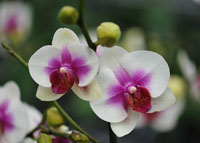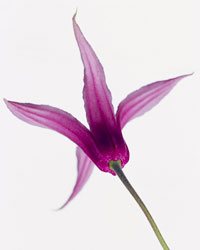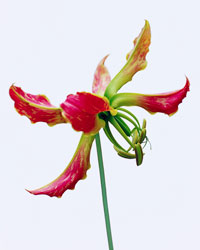
Characteristics of Orchids

Orchids have a unique flower structure which consists of four main parts. The orchid flower is typically has an outer whorl of three sepals, an inner loop of three petals, a single large column in the center, and an enlarged bottom petal called a lip or labellum. The overall flower shape is characteristically bilaterally symmetrical (the left and right halves of the blossom are mirror images), a necessity for reliable pollination by bees.

The two lateral petals flank the greatly enlarged flamboyant bottom labellum, which is usually highly modified to attract and, in some cases, trap potential pollinators. The lip may be differently colored or marked, ruffled or pouch shaped, decorated with crests, tails, , hairs, fans, or other decorations attractive to their selected pollinator.
The orchid's reproductive system is combined into a single column. This is the primary identification feature of an orchid. At the top of the column is the anther, which contains packets of pollen and below the anther is the stigma, a shallow, sticky cavity in which the pollen is placed for fertilization.
- Sepals: Although they may look like petals, they are actually the glorified remains of the flower bud. There are usually three of approximately equal size.
- Column: A finger-like structure that carries the orchid's reproductive system--the stigmatic surface and the pollinia located under the anther cap.
- Petals: Orchids always have three petals. Two are "normal," and the third becomes a highly specialized structure called a lip.
Some orchid species are among the world's smallest flowering plant like Eurystyles or many Pleurothallidinae plants. Some others can reach 4 meters height like Selenipedium (growing in Tropical America) or Grammatophyllum papuanum (Papua-New Guinea). The number of genera is calculated at about 600, the number of species between 25,000 and 30,000 and the hybrids more than 100,000 already registered. The geographical distribution is not regular around the world. There are a few genera which are represented in almost every continent but, in general, they have a restricted distribution:
There are some features common to all species, which make a plant included in the "orchidaceae family". The orchid flower has the feminine and masculine organ of reproduction fusing in only one body called a column or gynostemium. The flower has an irregular form. It has three sepals and three petals. The medium petal is modified and is called labellum or lip. It is, in general, intensively colored and is the most interesting part of the flower from where the scent is exhaled in order to attract the agent of pollination.
Its form or scent can vary a lot: it can have the appearance of female bee (like Ophyrs), female wasp (like Drakea or Cryptostylis), a bucket (like Coryanthes), having a very sweet or disagreeable, strong or light perfume. Orchids do a lot to attract pollinators to guarantee the reproduction of the species. Orchids are not parasites, as people believe, they aren't fed by the host, they only use it to fix themselves well. In general, they are epiphytic, living on the trees or on the rocks (in tropical zones) or terrestrial (temperate zones). Extremely diversified plants, orchids are found all around the world, except in the deserts, so it is always possible to find one species which can thrive in the conditions you can provide. Although they can be found at from sea-level to 4,000 meters in altitude, they are most numerous between 500 and 2,000 meters above the sea.
